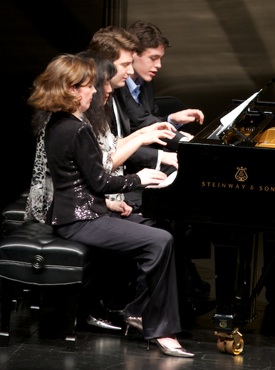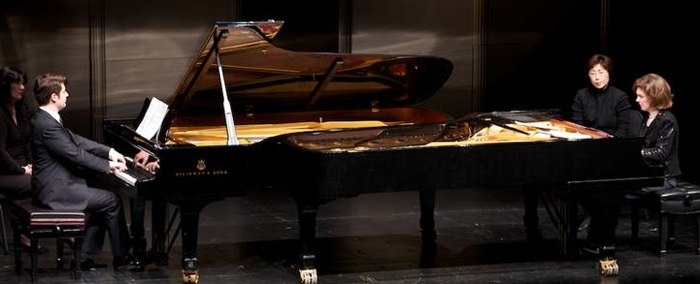Music@Menlo winter concert virtuosic and playful
If two heads are better than one, than four hands would trump two. Or so Wu Han, Alessio Bax and Anne-Marie McDermott would have us believe, and they made a very good case for that last Sunday, January 16, at the new Menlo-Atherton Center for the Performing Arts.
These three renowned pianists played a program entirely consisting of four-hands piano works, alternating players in a blistering display of challenging virtuosity and good-natured fun.

“Pianists are lonely animals,” said Wu Han, the organizer of this series and of the popular summer festival, which she started with cellist and husband David Finckel. “And so it’s great to have a piano party!”
Bax and McDermott started off with Claude Debussy’s Nocturnes, a colorful orchestral work which Maurice Ravel arranged for two pianos.
And that goes to the heart of this concert.
Both Ravel and Debussy were known for their brilliant orchestration, creating piquant colors with splashes of woodwinds, harps and triangles. Moving away from the brass-heavy orchestras of Wagner and Mahler, they helped define a French school of music. Debussy furthered a sense of ethereality with unusual whole tone and octatonic scales, the harmonies of which give a “watery” quality, his signature, and earning him a distinction as the founder of “Impressionist” music.
He based the Nocturnes on four similarly titled paintings by Whistler, studies in lights and grays that bridged the Tonal and Impressionist art schools. Debussy’s musical pastels and splashes of color could hardly be thought of as monotonal. Except that he described them as shades of gray! Once one hears the reduction from orchestral into piano duet, those careful distinctions emerge like the wealth of nuance in a black and white photograph.
What was curious about this concert was how the pianos evoked color, while drawing our ear to Whistler’s fine gradations. In Nuages (Clouds) Bax played slow chords, elegant and almost aloof, as McDermott troubled the air with atmospheric rumbles. This was programmatic music of the highest order, immersing us in light-streaked fogs.
Fêtes was gleefully festive, while Sirènes (Sirens) called to us, exotic and be-spelling. Swift swirls of arpeggios washed across us, Bax in the mid-tones and McDermott at both extremes, drawing us into Debussy’s dream.
Wu Han traded places with Bax, launching into Sergei Rachmaninov’s Suite No. 2 for Two Pianos. She and McDermott were forceful, building complex chords into a majestic opening. The Waltz was lighter, but still with Russian edge, dramatic even in the quiet moments. But then it swelled, slow big-boned statements emerging out of fusillades of notes. These two pianists held an electric intensity as they built to a ferocious climax, a feat of clean fingering that had them both smiling at each other across the length of their pianos. Then a trickling finish, and a laugh.
The Romance was gentle and dreamy, and the Tarantella—a powerful ending. This well-known movement revealed the mature Rachmaninov. After seven years of intense self-doubt he emerged with the assurance and themes of his future concertos.
After intermission, Bax and Wu Han teamed for Rachmaninov’s Fantasie-tableaux, his first suite for two pianos, written in 1893 at the impossibly young age of twenty. Based on four poem fragments, it is filled with the contradictory passions of youth. (Wu Han’s flair for drama was underscored by her flamboyant dress, a tissue of silver over a black body stocking, with silver stiletto heels.) “A Night for Love” was particularly sweet, and “Tears” held liquid longing. Its internal quality and clarity and showed off the chemistry between the two pianists.
McDermott and Bax raised the bar with Ravel’s La Valse, a work of gorgeous texture—and biting sarcasm. Based on the Viennese waltz, Ravel changed a tribute to Vienna into recrimination in his 1919 post-World War I work. Rumbles and “wrong” notes gave the heavy-footed waltz an undercurrent of war, and irreverent slides and high catcalls presaged the bitter cheer of Dada. Here the usually gentle Ravel is fever-bright, full of winks and wry winces.
After bows, a fourth pianist, the young Peter Asimov, joined them and all four squeezed along a single piano for a delightful romp, Lavignac’s Galop-Marche. Leaning in and out to strike chords, they launched into a breathless choreography, to end, as Wu said, in a piano party.
—Adam Broner
Photo top: Anne-Marie McDermott, Alessio Bax, Wu Han and Peter Asimov share a keyboard. Photo bottom of Wu Han and Alessio Bax. This article originally published in the Berkeley Times.

